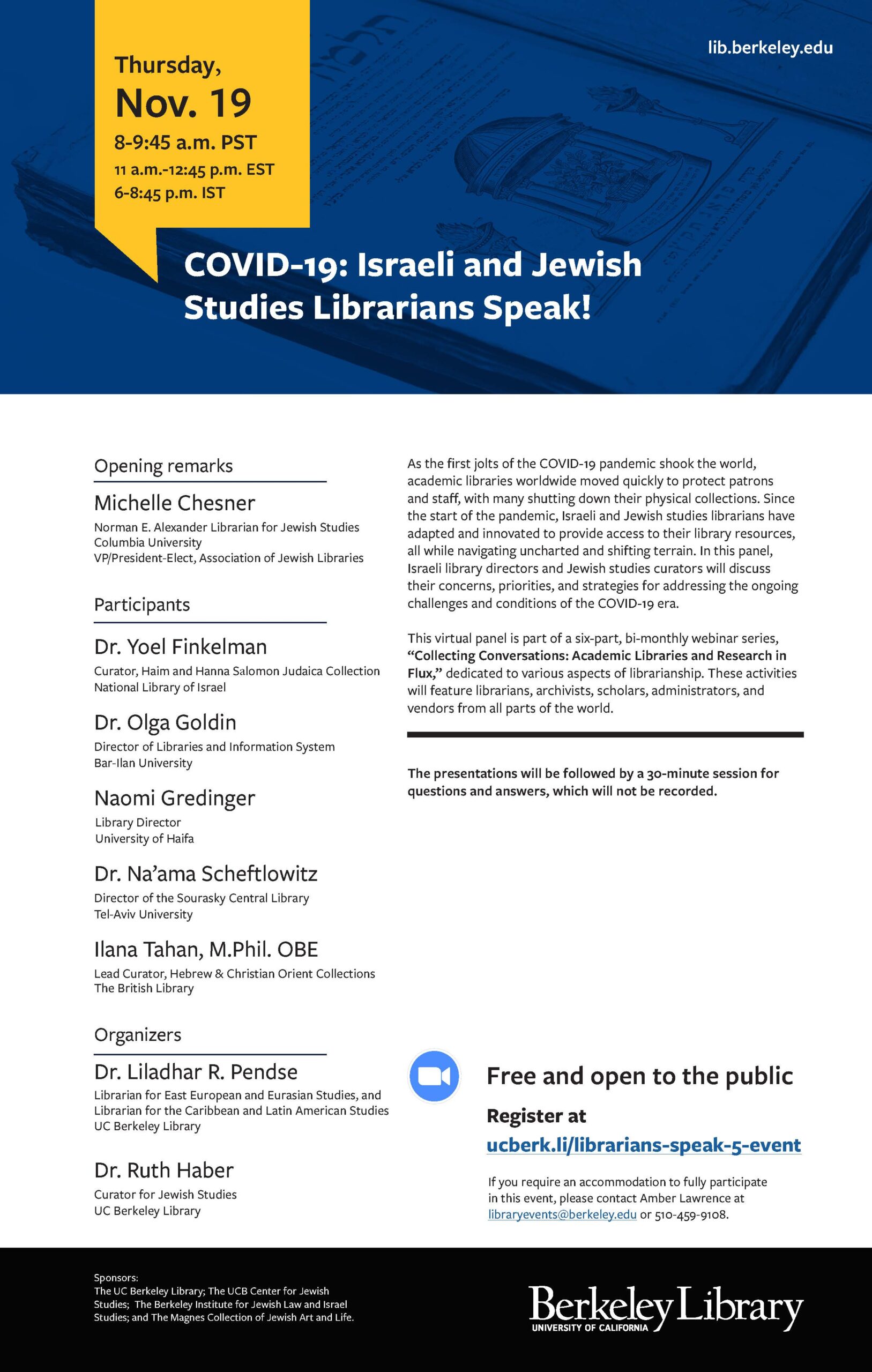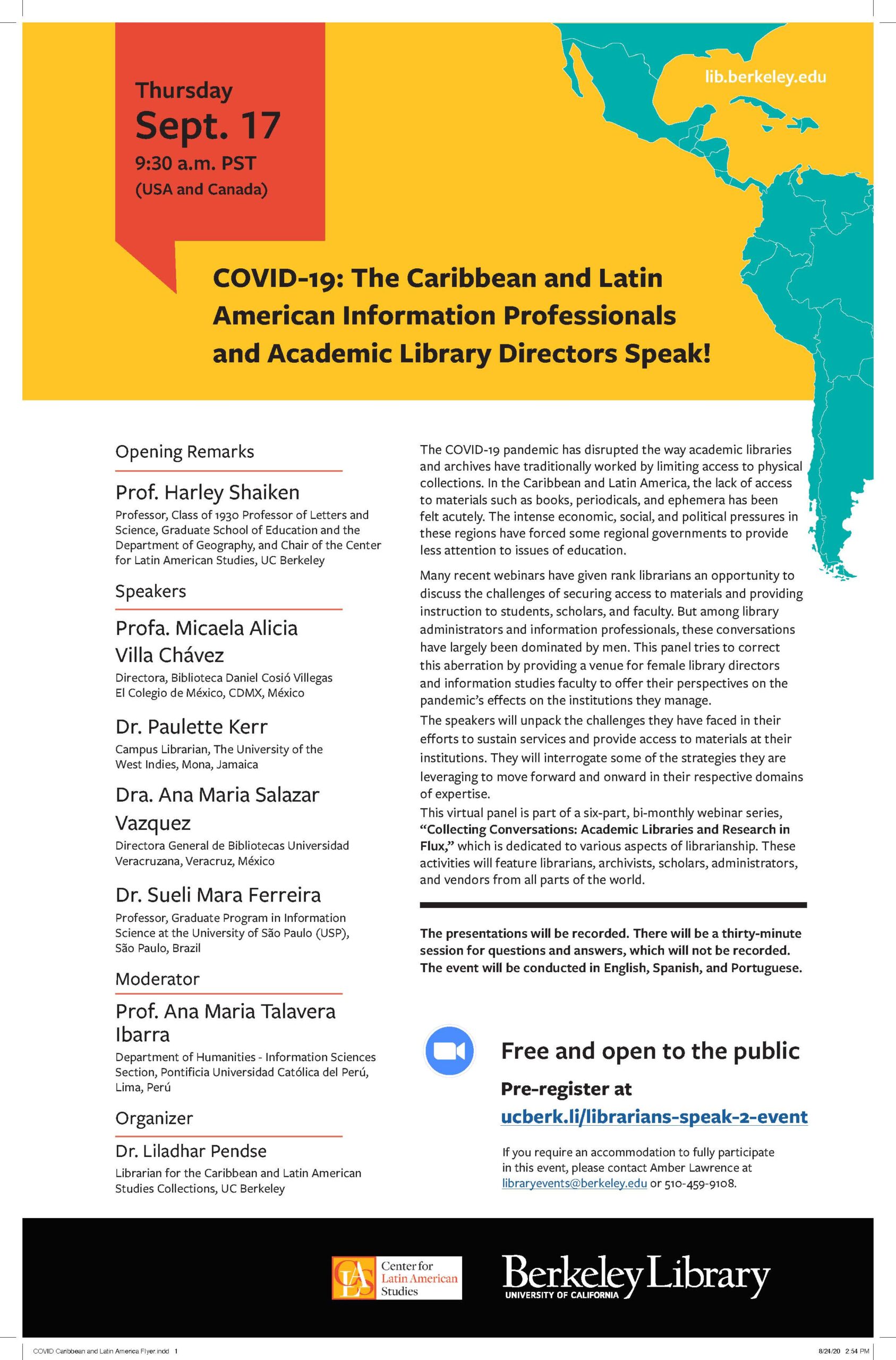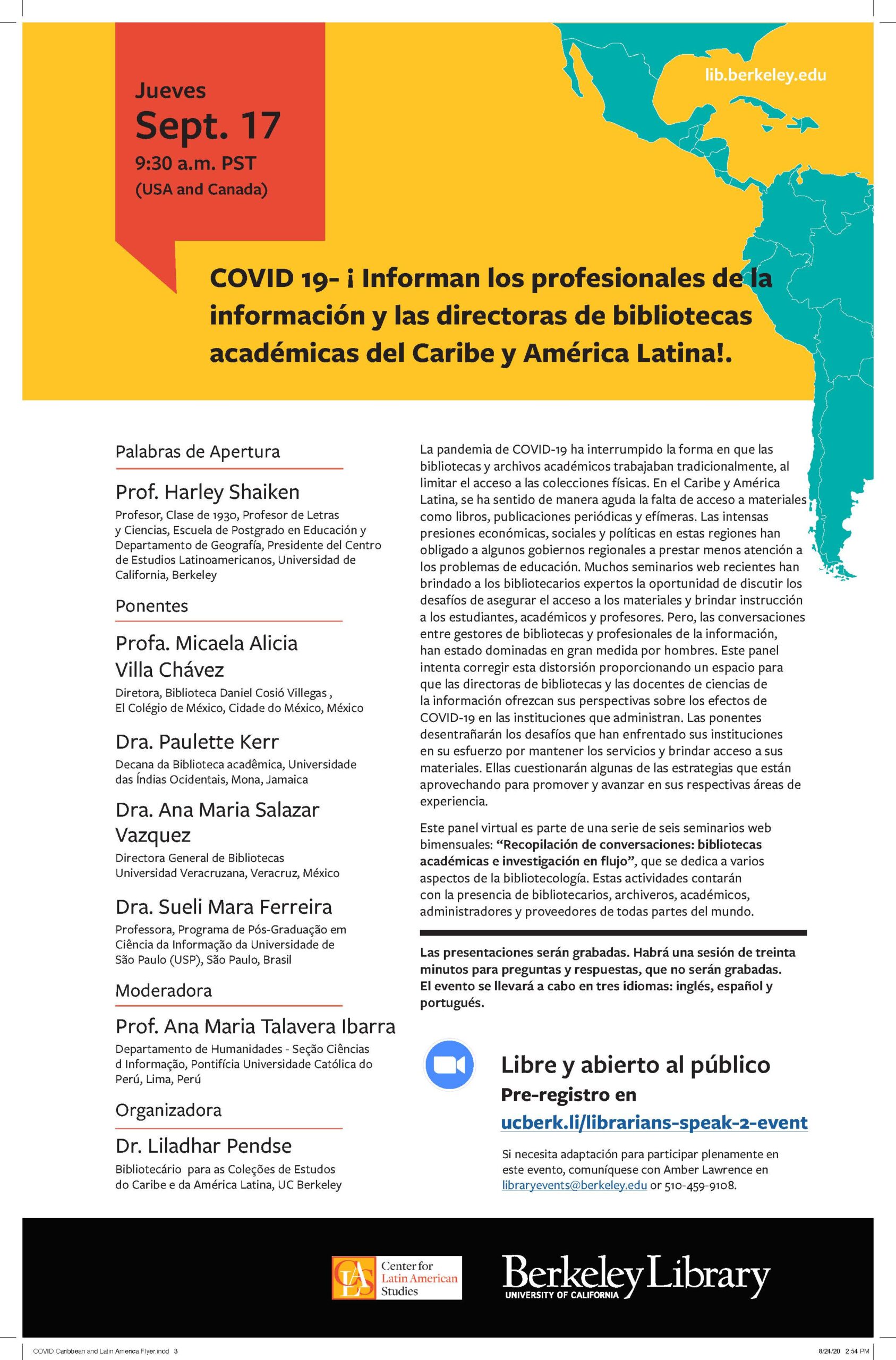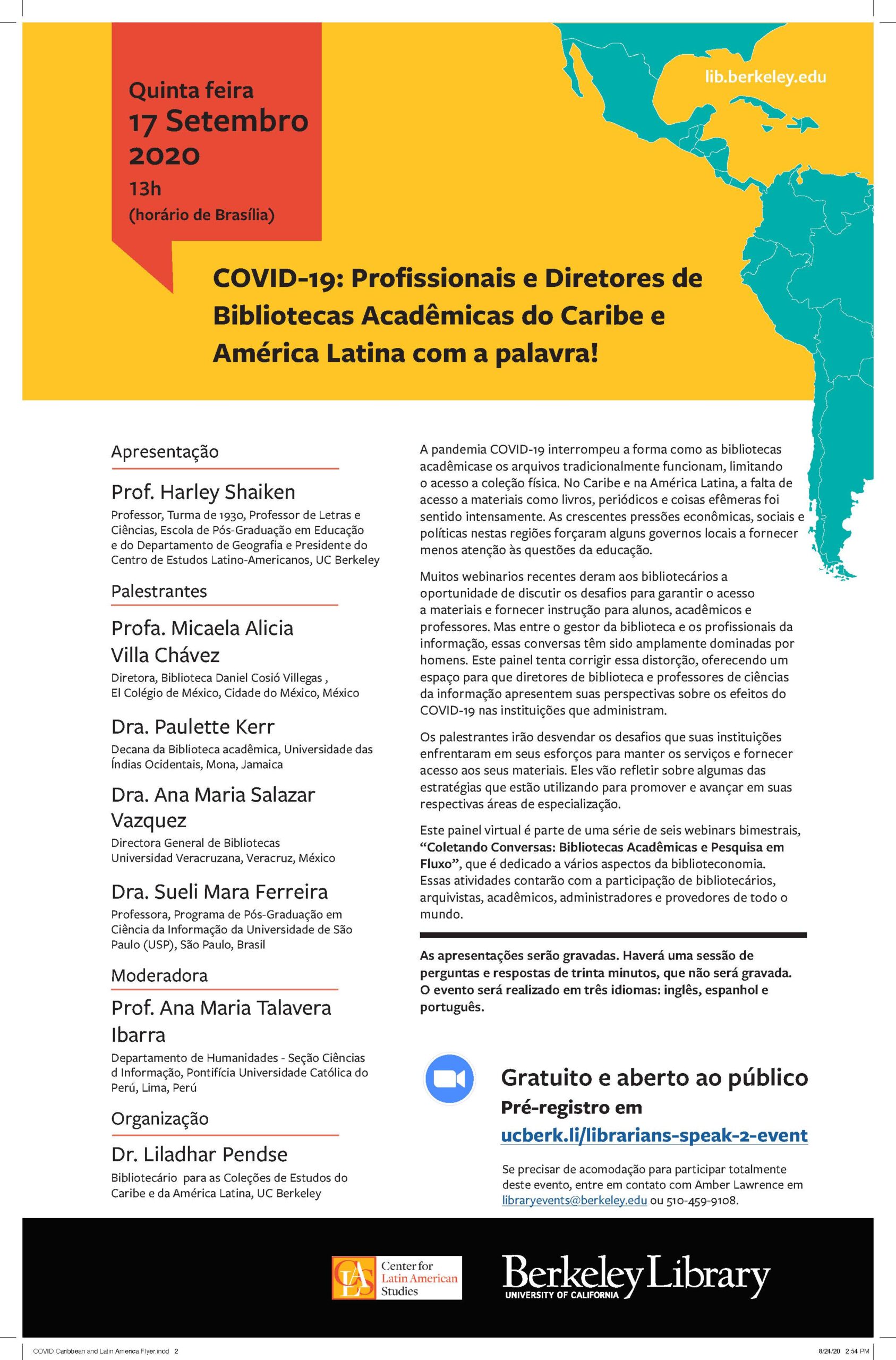Tag: free webinar
COVID-19: Israeli and Jewish Studies Librarians Speak (November 19, 2020)
This is the penultimate event in the series: “Collecting Conversations: Academic Libraries and Research in Flux,” that we have organized at our library. The registration information is here: https://berkeley.zoom.us/webinar/register/WN_CSqP-OQgRpulyYCTP-26XQ
A special note of thanks to Dr. Ruth Haber, our curator for Judaica Collections, and our campus partners for their generous support and encouragement: The UCB Center for Jewish Studies; The Berkeley Institute for Jewish Law and Israel Studies; and The Magnes Collection of Jewish Art and Life. Also, the event could not have been possible if not for the help from Library Administration and the Library Communications Team. ALL ARE WELCOME!

Save the date-September 17, 2020: COVID-19: The Caribbean and Latin American Information Professionals and Academic Library Directors Speak!
COVID-19: The Caribbean and Latin American Information Professionals
and Academic Library Directors Speak!
Thursday, Sept. 17
9:30 a.m. PST (USA and Canada)



Racial-Ethnic Disparities in Birth Outcomes: A Life-Course Perspective
Does your work involve women and infants of color? Are you interested in learning about the life course perspective and its effects on risk factors during pregnancy? Then you might be interested in this webinar hosted by the Office of Minority Health Resource Center (OMHRC)! In it, Dr. Lu presents evidence that suggests that risk factors happen prior to conception which puts an emphasis on treating the whole person and not just the symptoms.
When: May 3, 9:00 – 10:00 am PT
Cost: Free!
Presenter: Dr. Michael Lu, Professor of Prevention and Community Health at the George Washington University School of Public Health
More information and registration information is available from the Office of Minority Health Resource Center (OMHRC).
Beyond the SEA: Partnering to Transform the Care Environment for Transgender and Gender-Expansive Patients
Want to learn about some evidence-based resources that inform health professionals on the unique medical needs of transgender patients? Wish to help health professionals understand the social determinants of health that impact transgender and gender-expansive individuals? Then this webinar may be of interest to you!
During this presentation, you will review the vocabulary around gender identity and expression, provide an overview of the information needs of both health professionals and patients, and highlight available online resources and other training opportunities that can be shared with health professionals.
Date: April 5, 2018
Time: 11:00am-noon PT
cost: Free
Audience: Health professionals, health science librarians, and other health focused groups
Presenter: Dr. Scott Nass. President-Elect, GLMA: Health Professionals Advancing LGBT Equality. Pronouns: He/Him/His
Host: National Network of Libraries of Medicine, Southeastern/Atlantic Regional Medical Library (NNLM SEA)
Beryllium Health Effects on Workers: A COEH webinar
This webinar will review recommendations for practitioners regarding the diagnosis and management of beryllium sensitivity and chronic beryllium disease published in an official American Thoracic Society (ATS) statement in 2014. The ATS statement was prepared with the support and input of both NIOSH and the U.S. Department of Labor (DOL). It will also discuss federal OSHA’s new Final Rule to Protect Workers from Beryllium Exposure.
Learning Objectives:
* Describe how to make the diagnosis of beryllium sensitization
* Describe how to make the diagnosis of chronic beryllium disease
* Identify key features of the new OSHA beryllium standard
When: Wednesday, April 4
Time: 10:30-11:30am
Cost: Free! or $30 for CE credit. CE credit requires additional registration to complete payment and an evaluation after viewing the webinar
Speaker: Dr. John Balmes of UCSF and UCB. Dr. Balmes’ laboratory, the Human Exposure Laboratory (HEL), has been studying the respiratory health effects of various air pollutants for the past 27 years.
You’ll find more information and registration details on the COEH website.
Community Health Maps: Using Mapping Tools During Disasters : A webinar recording
Perhaps you’ve seen the way others use mapping in public health and wanted to try it yourself but are overwhelmed by the technology and/or simply too busy to pursue it. Or maybe you are already engaged in mapping but wish to enhance your community mapping initiatives with other tools. Now there’s a blog that was created to facilitate the use of GIS mapping for those that fall into these categories. This webinar, recorded on October 12, provides an overview of the tools available for you on the Community Health Maps blog and how they can be utilized during disaster response.
The Center for Public Service Communications and its partner Bird’s Eye View, together with the National Library of Medicine (NLM), have developed the Community Health Maps (CHM) initiative. The goal of this blog is to provide information about low cost mapping tools that can be used by community organizations.
The webinar discusses three GIS tools: Fulcrum for iOS and Android, QGIS for the desktop pc, and Carto which is a cloud-based platform. It also includes several case studies from around the country involving different populations so that you can see how these could be used.
Under its resources tab, the blog includes lab exercises to take you through the entire Community Health Mapping Workflow from field data collection through online data presentation. These are also available for you on YouTube.
This is a collaborative effort between the National Library of Medicine, the Center for Public Service Communications and Bird’s Eye View.
Improving the availability of reliable health information: A webinar
Do you use disaster related health information in your work? Would you like to learn more about it? If so, then you might want to attend this webinar by the US National Library of Medicine (NLM)’s Disaster Information Research Center. In it, Robin Taylor, MLIS and Dr. Neil Pakenham-Walsh will provide an overview of two powerful platforms that promote access to health information for those involved in disaster, public health emergency, and humanitarian situations.
Ms. Taylor will describe the scope of the Disaster Lit database maintained by the US National Library of Medicine (NLM). She will talk about the process used to select high-quality resources which are freely available on the internet, as well as the medical and public health aspects of disaster and public health emergency preparedness and response.
Dr. Pakenham-Walsh will discuss how his organization, Healthcare Information For All (HIFA), promotes communication among stakeholders to move toward a world where every person will have access to the healthcare information they need to stay healthy.
When: Thursday, November 9, 2017
Time: 7:00 a.m. PT
Ms. Taylor, MLIS, selects electronic resources about disaster health for inclusion in the Disaster Lit database and provides communications support.
Dr. Pakenham-Walsh is the coordinator of the HIFA campaign and co-director of the Global Healthcare Information Network. For the last 20 years he has worked to improve the availability and use of relevant, reliable healthcare information for health workers and citizens in low- and middle-income countries.
This webinar is a part of Humanitarian Evidence Week, observed from November 6-12, 2017.
Tobacco and Public Health: From Theory to Practice: A Virtual Course on Tobacco Control (Version 2016)
Want to learn more about tobacco control in the Region of the Americas? Like to catch up on the latest evidence-based information on tobacco control science, policy and practice? Wish to read about the successful experiences of others in the Region? Then this free course, available in English and Spanish, might be of interest to you!
The course consists of 8 modules that are taken independently and may be completed in any order. Each module presents background information, global and regional data, the strategies of the tobacco industry to confront the policies, the information to counteract these strategies, and new challenges in the area.
Course Structure:
1. Tobacco epidemic: the problem and its solutions
2. Tobacco control: taxes and prices
3. Tobacco control: smoke-free environments
4. Tobacco control: health warnings
5. Tobacco control: ban on tobacco advertising, promotion, and sponsorship
6. Prevention
7. Cessation
8. Tobacco product regulation
Learning Objectives
* Describe the nature and extent of the tobacco epidemic at the global level and in the Region of the Americas.
* Describe solutions available to curb the tobacco epidemic: the WHO Framework Convention for Tobacco Control (FCTC), its guidelines for implementation, and the WHO MPOWER package.
* To understand the role of tobacco in the context of noncommunicable diseases and to analyze the WHO “best buys” related to tobacco control.
* Describe the tobacco industry’s opposition strategies and list possible responses to these actions.
* Describe the strategies and characteristics of smoking cessation at the individual and population levels.
* Explain the rationale for, and approaches to, tobacco product regulation.
* Analyze new challenges for tobacco control.
The initial idea for this course originated in 2003 with the Ontario Tobacco Research Unit (OTRU) in Ontario, Canada, with the support of the Ontario Ministry of Health Promotion, as part of the Smoke-Free Ontario Strategy. In 2007, the Pan American Health Organization adapted it for the Region of the Americas countries.
Violence in the Health Care Workplace – Research and Policy Update: A free Webinar
Do you work with health care workers, a population who face increased risk of workplace violence? Would you like to learn about effective interventions that can reduce their risk for WPV? Do you want to learn more on the Cal/OSHA standard for WPV in health care? If so, then you might want to watch this webinar where Dr. Robert Harrison will address these issues.
The Center for Occupational and Environmental Health (COEH) will be streaming this webinar for free on Facebook Live! Log on to the COEH facebook page on September 6 to join in.
When: Wednesday, September 6, 2017
Time: 10:30 AM – 11:30 AM (Pacific Time)
Where: Log in to https://www.facebook.com/UCCOEH/
This Webinar is available for Continuing Education credits for nurses, and may be eligible for ABIH credits for industrial hygienists. The cost for CE credit is $30 per webinar.
A New Look at Ways to Minimize Work Disability and Job Loss after Illness or Injury: A free NIOSH webinar
NIOSH is offering a free Center for Workers’ Compensation Studies (CWCS) webinar in which speakers will describe recent work by the Stay-at-Work/Return-to-Work (SAW/RTW) Policy Collaborative established by the U.S. Department of Labor’s Office of Disability Employment Policy (ODEP). The webinar will also discuss products developed by the Collaborative that are available for download and distribution.
The Collaborative supports the development of policies, programs, and practices that encourage the continued employment of workers likely to leave the workforce due to injury, serious illness, or disability.
The three Policy Working Groups in the Collaborative are:
– Replicating and Adapting the State of Washington’s Centers of Occupational Health and Education (COHE) Model
– Musculoskeletal Conditions and Pain Management
– Transition Back to Work
When: September 6
Event Schedule:
9:00-9:45 am: Presentation
9:45-10:00 am: Q/A